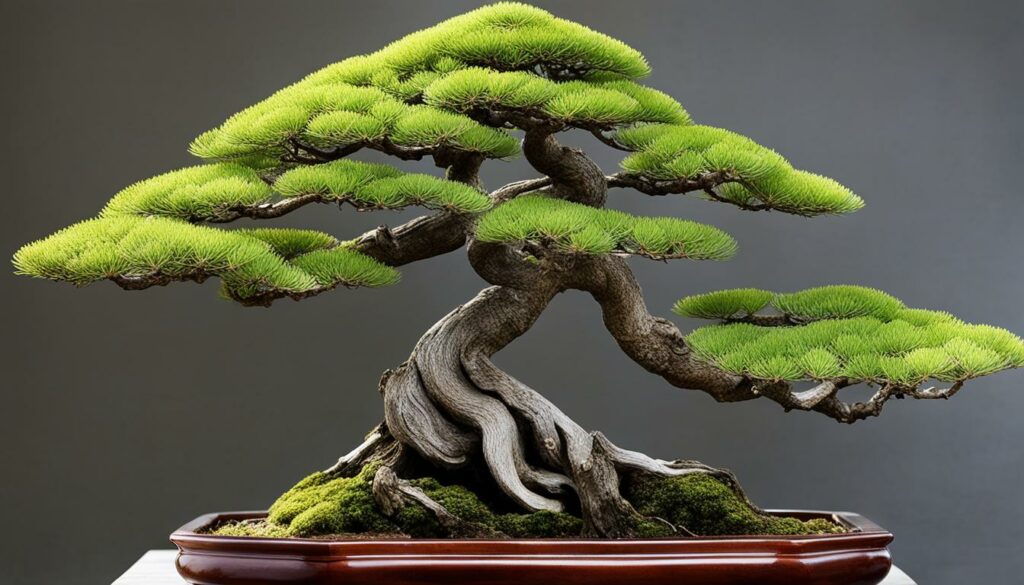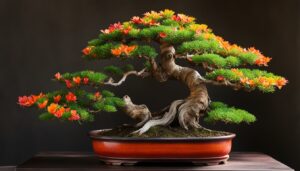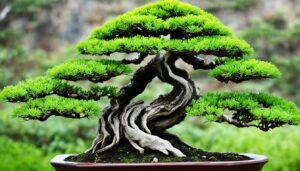Creating a beautiful and harmonious bonsai tree requires attention to detail at every stage of planting, cultivation, and growth. One of the most crucial aspects of bonsai styling is the trunk, which forms the foundation of the miniature tree. When styled correctly, the bonsai trunk can impart a sense of movement and grace to the overall composition, enhancing the aesthetic appeal of the entire bonsai tree.
There are several techniques you can employ to sculpt and shape your bonsai trunk, including trunk thickening, tapering, and design. By understanding these techniques and incorporating them into your bonsai styling practice, you can create stunning bonsai trees that are sure to impress.
Key Takeaways:
- Bonsai trunk styling is an essential element in creating visually appealing and harmonious bonsai trees.
- Techniques such as trunk thickening, tapering, and design can help you shape your bonsai trunk with precision.
- Proper pruning, wiring, and selecting appropriate species are some essential practices that must be followed to ensure effective bonsai trunk styling.
- The successful styling of the bonsai trunk can greatly contribute to the overall aesthetic appeal of the miniature tree, making it a sight to behold.
- It takes time, patience, and consistent maintenance to develop and maintain stunning bonsai trunks.
Understanding Bonsai Styling Trunk
When it comes to the art of bonsai, the trunk is the foundation upon which everything else is built. Bonsai Styling Trunk is a discipline that involves sculpting the trunk into a visually appealing and natural-looking shape.
The trunk of a bonsai tree is its most prominent feature and sets the tone for the entire tree. A well-designed trunk can evoke a sense of harmony, balance, and flow, while a poorly designed one can disrupt the tree’s overall aesthetic and reduce its visual appeal.
Styling the trunk of a bonsai tree involves careful planning and an understanding of the tree’s natural growth patterns. Factors like trunk thickness, taper, and overall shape must be considered to achieve an aesthetically pleasing trunk design.
Bonsai Styling Trunk aims to replicate the appearance of a full-size tree’s trunk, but on a much smaller scale. This process often involves shaping the trunk by thickening, tapering, and creating an overall natural flow. A skilled bonsai artist combines artistry and technical knowledge to create an authentic-looking bonsai trunk.
Techniques for Trunk Thickening
To achieve a thick, sturdy trunk in your bonsai tree, there are several techniques that you can use. One effective method is trunk-chopping, which involves cutting the trunk down to a lower point and allowing new growth to emerge from the remaining trunk. This promotes the development of a thicker trunk and creates a more compact tree. Keep in mind that this method requires significant recovery time before new growth appears.
Another technique is to use sacrifice branches, which are branches that are allowed to grow unchecked to encourage the trunk to thicken. Over time, sacrifice branches can be removed, leaving a robust, thick trunk. Proper pruning is also essential for promoting trunk thickening, as removing smaller branches from the trunk directs more nutrients to the remaining branches, stimulating growth and thickening.
Pro Tip: Apply gradual pressure to the trunk by wrapping it tightly with wire, twisting the wire every few months to constrict growth and promote thickening.
Be patient when using these techniques, as they can take several growing seasons to produce the desired results. A combination of methods can be used depending on the specific bonsai tree species and your desired design.
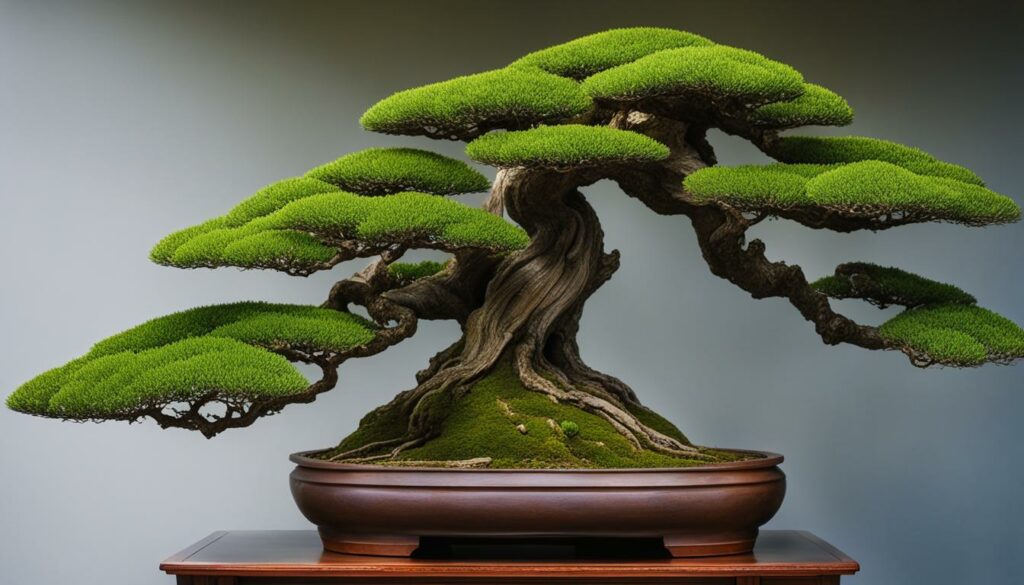
Creating Taper in the Trunk
Taper is an essential aspect of bonsai trunk design and creates a sense of balance and harmony in your tree. The gradual decrease in trunk diameter from base to apex creates an elegant and natural appearance. Achieving the right taper requires skill and patience, but can be accomplished through several techniques.
Clip and grow: This technique involves strategically pruning the upper branches of the tree while allowing the lower branches to grow freely. As the lower branches thicken, they will create taper in the trunk.
Wiring: Wiring is another technique that can be used to create taper in the trunk. Gently wire the trunk, starting at the base and working your way towards the apex, using progressively thinner wire. This will allow the trunk to gradually taper as it grows.
Selection of appropriate species: Different species of bonsai trees have unique growth patterns and characteristics. Choosing a species that naturally tapers can make it easier to achieve the desired effect.
When using any of these techniques, it is essential to monitor the health of your bonsai tree. Improper techniques can result in damage or death to the tree. With patience and attention to detail, you can create stunning taper in your bonsai trunk.
Designing the Trunk Shape
Creating a visually pleasing and harmonious trunk shape is an essential aspect of bonsai styling. Trunks make up the ‘skeleton’ of a bonsai tree, providing an outline for the rest of the design elements to follow. When designing the trunk shape of your bonsai tree, it is crucial to consider principles such as movement, balance, and aesthetics.
Movement refers to the sense of flow or visual ‘path’ that the trunk creates. A meandering or twisting trunk can generate a feeling of dynamism in your bonsai tree, while a straight, upright trunk can convey strength and stability. Balance involves ensuring that the trunk appears harmonious and proportional to the rest of the tree’s design elements. A trunk that is too thin or too thick may look out of place in the overall composition. Aesthetics refer to the overall visual appeal of the trunk design, considering factors such as texture, color, and patterns.
When designing the trunk shape of your bonsai tree, consider the overall style you wish to achieve and select suitable species. Some styles, such as the windswept or cascading styles, may involve more dramatic trunk shapes than other styles, like the formal upright style. Keep in mind the size and placement of your bonsai tree, as the trunk should not appear disproportionate to the pot or landscape.
Tip: Sketching your desired trunk shape on paper can help you visualize the design before committing to cutting or wiring.
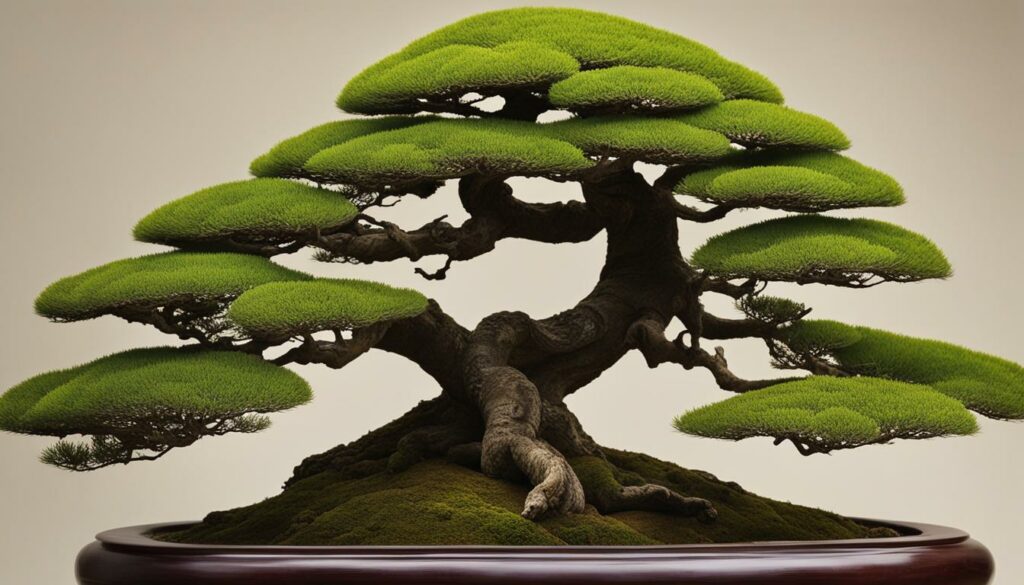
“The trunk serves as the backbone to the tree, dictating the style and overall visual appeal of the bonsai.”
Selecting the Right Bonsai Style
To fully bring out the beauty of your bonsai, you must select the right style that complements the tree’s natural curves and aesthetic. By taking consideration of various styles like formal upright, informal upright, cascade, and windswept, you can bring out the best of your bonsai.
For instance, formal upright is the classic choice, usually involving a straight trunk and a triangular shape. Informal upright, on the other hand, carries more variation with curves along its entire length and minimal taper. Cascade style features a trunk that cascades downwards, while windswept bonsai exhibits shapes that show the effects of heavy winds on its appearance.
It’s essential to consider the size, movement, and growth pattern of the trunk to choose the most suitable style. Your expertise in thickening, tapering, and designing the bonsai trunk comes into play here as you select the right style.
The key here is to strike a balance between the style and the trunk’s appearance to create an overall harmonious bonsai.
Tools and Equipment for Bonsai Trunk Styling
Creating the perfect bonsai trunk requires careful attention to detail, and having the right tools and equipment is essential. Here’s a list of must-have tools for successful bonsai trunk styling:
| Tool | Purpose |
|---|---|
| Pruning Shears | To remove small branches and leaves and perform other precision trimming of the tree. |
| Wire Cutters | To help position and support branches and trunks with wires. |
| Concave Cutters | To help remove branches, making pruning easier and more precise. |
| Bonsai Wire | To shape and bend trunks and branches into the desired position during the growth process. |
Other essential tools include root scissors, a branch bender, pliers, and a pruning saw.
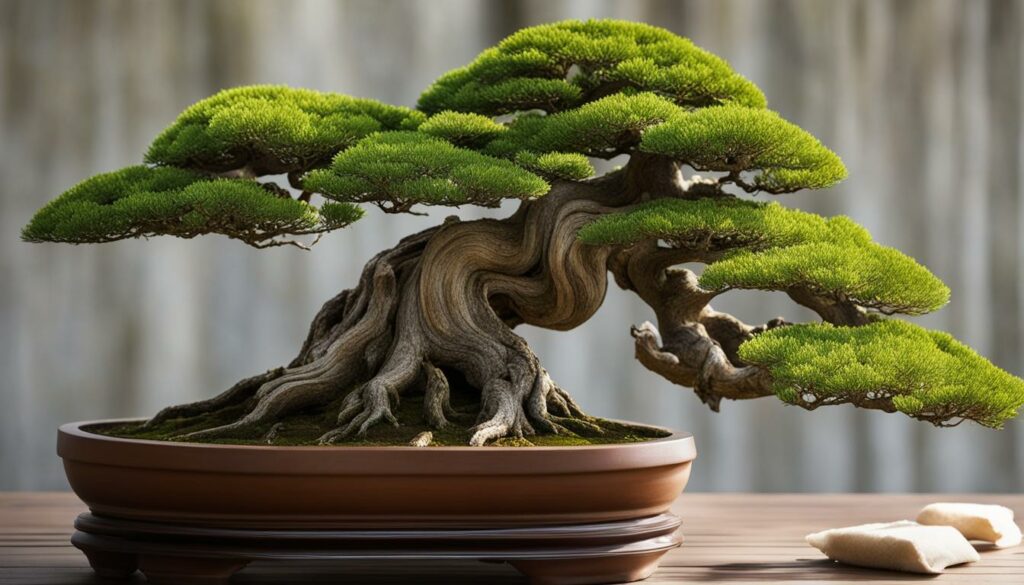
Being prepared with the right tools and equipment is crucial to achieving the perfect bonsai trunk. Make sure to have all the necessary instruments ready before you begin your next bonsai project.
Preparing the Trunk for Styling
Before you begin styling your bonsai trunk, it is crucial to prepare it properly. The trunk is the foundation of your bonsai tree, and its health and condition will greatly affect the success of your styling efforts. Follow these steps to ensure optimal conditions for successful styling:
Assess the Health of the Trunk:
Inspect your tree for any signs of disease, insect infestation, or other health issues. Address any problems before styling to prevent further damage to the tree.
Clean the Trunk:
Use a soft brush or cloth to gently remove any debris or dirt from the trunk. This will make it easier to see the tree’s structure and determine the optimal areas for styling.
Prune the Tree:
Remove any dead, damaged or diseased branches from the tree. This will help redirect energy to the healthy parts of the tree and promote new, healthy growth.
Image Alt Tag: Bonsai Styling Trunk
Wrap Up:
By taking these steps to prepare your bonsai trunk for styling, you are setting a solid foundation for the design and development of your tree. With a healthy, clean trunk, you will be better able to visualize the ideal shape and style to complement your bonsai tree’s growth and unique characteristics.
Pruning Techniques for Trunk Styling
To achieve the desired design for your Bonsai Styling Trunk, pruning is a key technique to enable proper shaping. In this section, we’ll discuss the strategies you can use to prune your bonsai tree’s trunk, so it meets your desired design.
Directional Pruning
Directional pruning involves removing branches that grow in an undesirable direction.
This technique enables the trunk to grow and thicken in the optimal direction.
Strategic Branch Removal
Strategic branch removal is an effective technique for promoting trunk tapering.
It involves removing branches that impede the taper of the trunk.
Apex Management
Apex management involves pruning the dominant leader or top of the tree to encourage growth of side branches.
It helps create a well-balanced trunk and an overall cohesive Bonsai Styling Trunk design.
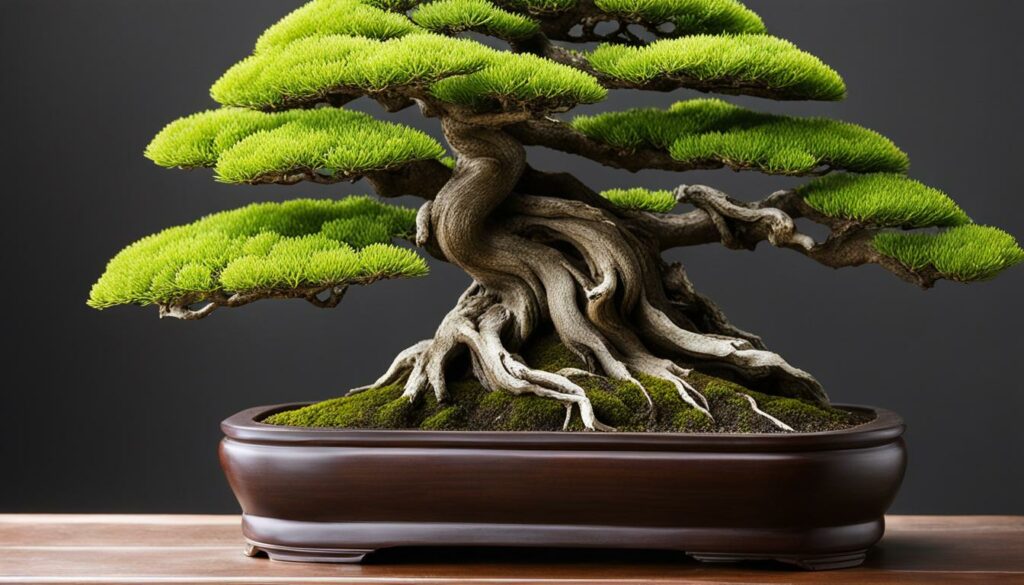
As you can see, pruning plays a crucial role in the development of a visually appealing Bonsai Styling Trunk. By using these pruning techniques, you can sculpt your tree into a masterpiece that will impress all who see it.
Wiring the Bonsai Trunk
Wiring plays a critical role in Bonsai Styling Trunk. It is the process of wrapping the trunk and branches with wire to bend them in the desired direction. The purpose of trunk wiring is to create an elegant, natural-looking curve in the trunk. It also helps in positioning the branches and shaping the silhouette of a bonsai tree, making it look more attractive.
The best time to wire a bonsai trunk is in the fall or spring when the tree is actively growing. However, if the tree is weak or sick, it should not be wired. You must also take care not to wire the trunk too tightly, which could damage the bark and harm the tree.
The wiring technique is simple: wrap the wire around the trunk, starting from the base of the trunk and working your way up to the apex. Be sure to wrap the wire close enough to bend the tree to your desired position and keep it loose enough to avoid causing any damage.
For achieving natural-looking results, you must follow the natural curve of the trunk. You can use different gauges of wire depending on the size of the trunk, with smaller gauges for smaller trunks and thicker gauges for larger trunks.
Tip: To prevent wire from leaving marks on the bark, which can cause the tree to grow in odd directions, use raffia (a natural fiber) to wrap the trunk against the wire.
How to Remove Bonsai Trunk Wiring:
After a few months, the bonsai tree’s trunk will have grown and set in the wired direction. At this point, you need to remove the wire to prevent it from digging into the bark of the tree.
You can remove the wire by gently unwrapping it in the opposite order of how you installed it. If the wire is wrapped too tightly, use a pair of wire cutters to clip the wire off, making sure not to damage any of the tree’s trunk or branches by doing this.
Tip: Be sure to check the wiring after a few weeks to make sure the wire has not dug too deep into the bark, which can harm the tree.
Developing Nebari (Surface Roots)
Nebari, the surface roots of a bonsai tree, are essential for creating a visually appealing and healthy tree. A strong nebari anchors the tree in the soil and provides vital support for the trunk and branches.
There are several techniques for developing and enhancing nebari, including:
- Air Layering: This method involves removing a section of bark from the trunk near the soil line and applying rooting hormone to encourage the growth of new roots. Once the roots have formed, the top of the tree can be safely removed and potted to grow further.
- Root Pruning: Root pruning involves carefully removing the tree from its pot and pruning the roots around the perimeter of the root ball. This encourages the growth of new feeder roots near the trunk, resulting in a denser and stronger nebari.
- Proper Placement: Placing the tree in a shallow container encourages the roots to spread horizontally, resulting in a wider and more mature-looking nebari.
It is important to note that nebari development is a process that takes time and patience. Consistent and gradual approaches are best for achieving optimal results.
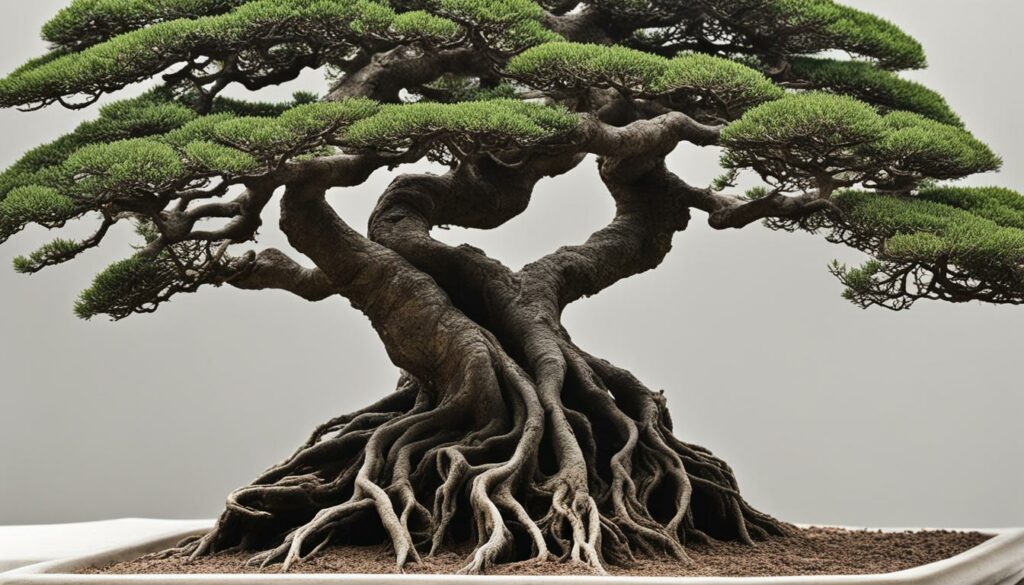
“A strong nebari anchors the tree in the soil and provides vital support for the trunk and branches.”
Treating and Preventing Trunk Issues
As a bonsai enthusiast, you know that the trunk is the most crucial element in creating a stunning miniature tree. Unfortunately, scars, diseases, and pests can hinder the overall aesthetic of a bonsai tree and compromise its health. Here are some tips for diagnosing, treating, and preventing common trunk issues to ensure healthy and visually appealing bonsai trunks.
Firstly, it’s important to inspect your bonsai regularly for any signs of damage or disease. Look for symptoms such as discoloration, holes, or cracks in the trunk, which could indicate pest infestation or fungal infections.
If you discover any issues, take swift action to treat them. For instance, if you notice any signs of pests, such as spider mites, aphids, or scale, try using insecticidal soap or neem oil to control the infestation.
Similarly, for fungal infections, you can try using a copper fungicide or applying rubbing alcohol to the affected area. It’s also a good idea to remove any dead or diseased parts of the trunk to prevent the spread of infection.
In addition to treatment, prevention is key in maintaining the health of your bonsai trunk. One simple way to prevent trunk issues is to ensure optimal growing conditions, such as providing sufficient sunlight, air circulation, and appropriate watering. It’s also essential to maintain clean soil and prune your bonsai regularly to prevent overcrowding and improve ventilation.
By following these tips, you can effectively diagnose, treat, and prevent common trunk issues that may arise in bonsai cultivation, ensuring healthy and visually appealing bonsai trunks.
Integrating Trunk Styling with Other Bonsai Elements
Bonsai trees are complex works of art that require careful consideration of each element to achieve harmony and balance. The trunk is just one part of the whole that must be integrated with other bonsai elements to create a cohesive design. By combining the right techniques for Bonsai Styling Trunk with complementary branch styling, foliage arrangement, and pot selection, you can create a beautiful and captivating bonsai tree.
Styling Branches
The selection and styling of branches should complement and follow the design of the trunk. A formal upright bonsai tree, for example, features branches that grow upwards and outwards in a symmetrical pattern, while a cascading style bonsai tree has branches that flow downwards. Proper branch styling emphasizes the overall shape and aesthetic of the bonsai and makes it stand out.
Arranging Foliage
The foliage is another essential component of a bonsai tree and contributes to its overall beauty and balance. When arranging foliage, consider the overall design of the bonsai and select a pattern that complements the styling of the trunk and branches. The foliage should provide visual interest and emphasize the bonsai’s design.
Selecting the Right Pot
The pot is not just a decorative element but an integral part of the bonsai design. The pot’s color, shape, and size should follow the style and design of the bonsai trunk and branches. For example, a cascading style bonsai tree requires a pot with a larger base and narrower top to emphasize its graceful flow, while a formal upright style bonsai tree is best suited for a simple, rectangular pot.
Integrating trunk styling with other bonsai elements is vital to creating an aesthetically pleasing bonsai tree. Careful consideration of the branches, foliage, and pot can elevate the overall design and make it stand out.
Training and Maintaining Trunks over Time
Now that you have achieved the perfect bonsai styling trunk, it’s essential to continuously train and maintain it to preserve its design and health. With regular care and attention to detail, you can ensure that your bonsai tree remains a masterpiece.
Wiring Adjustments
Bonsai wire is an essential tool in styling the trunk of your bonsai. As the trunk grows, the wire can cause harm to the tree if it’s not removed or adjusted in time. To prevent wire cutting into the bark, check your tree regularly and remove or adjust wire as necessary. Remember to always be gentle when removing wire to avoid damaging the bark.
Selective Pruning
Regularly removing dead or damaged branches and leaves is essential for the maintenance of your bonsai tree’s trunk. Proper pruning techniques promote healthy growth and create a pleasing overall shape. Be mindful when pruning and remove only what is necessary to avoid causing unnecessary damage to the tree.
Monitoring Tree Health
Checking your bonsai tree’s overall health regularly can help you identify and address any potential issues early on. Make sure to water and fertilize your tree properly, as appropriate for the species. Be on the lookout for signs of pests, diseases, and other issues, and take swift action if needed.
Tip: Document your bonsai tree’s growth progress with regular photos. This will help you see how your trunk styling techniques have contributed to the overall health and appearance of the tree over time.
Showcasing Your Bonsai Trunk
Congratulations on successfully styling your Bonsai trunk! Now you’re ready to show off your beautiful creation. Here are some tips on how to display your bonsai trunk:
- Choose an appropriate stand: The stand you choose should complement your bonsai trunk’s style and highlight its unique features. You could select a stand made of wood, stone, or metal, but ensure that it provides stability and good support.
- Add accent plants: Accent plants can improve the visual appeal and create a sense of balance between the bonsai and its container. Consider adding small plants in matching pots that complement your Bonsai’s color or shape.
- Lighting: Proper lighting can help enhance the beauty of your Bonsai and create a dramatic visual effect. You could place it near a window, garden, or invest in grow lights that provide the right amount of light.
Remember to change the orientation of your bonsai regularly when showing it off. This allows you to showcase different angles and highlight unique features from different perspectives.
“Displaying Bonsai is like decorating a room; the placement of the plant in the landscape or in the new environment is very important. Displaying it in different ways and from different angles can give you a whole new look and can make it stand out beautifully.” – Colin Lewis, Bonsai Master
Conclusion
Congratulations on completing our comprehensive guide to bonsai trunk styling! You now have the knowledge and skills to create visually appealing and harmonious bonsai trees through effective trunk styling techniques.
Remember that bonsai trunk styling is an art that requires patience, practice, and attention to detail. Ensure you have the right tools and equipment, prepare your tree properly, and select the appropriate techniques for your desired design.
Integrating trunk styling with other bonsai elements, maintaining tree health, and showcasing your masterpiece are all important aspects of bonsai trunk styling. By following the tips and techniques outlined in this guide, you can create stunning and captivating bonsai trunks that will impress any onlooker.
We hope you have found this guide informative and helpful. Happy bonsai styling!
FAQ
What is Bonsai Styling Trunk?
Bonsai Styling Trunk involves sculpting the trunk of a bonsai tree using various techniques to create visually appealing and harmonious designs.
Why is trunk development important in bonsai styling?
Trunk development is vital in bonsai styling as it forms the foundation and structure of the bonsai tree, giving it a mature and aesthetic appearance.
How can I thicken the trunk of my bonsai tree?
Trunk thickening can be achieved through techniques such as trunk-chopping, sacrificing branches, and proper pruning to promote growth and develop a sturdy trunk.
What is tapering in bonsai trunk design?
Tapering refers to creating a gradual decrease in trunk diameter from the base to the apex, which enhances the natural and artistic flow of the bonsai tree.
How do I design the shape of the trunk?
Designing the trunk shape involves considering principles such as movement, balance, and aesthetics to create a visually pleasing and harmonious bonsai trunk.
How can trunk styling enhance different bonsai styles?
Effective trunk styling techniques can complement and enhance various bonsai styles, such as formal upright, informal upright, cascade, and windswept, adding depth and character to the overall design.
What tools and equipment do I need for bonsai trunk styling?
Essential tools for bonsai trunk styling include pruning shears, wire cutters, concave cutters, and bonsai wire, each serving a specific purpose in the trunk styling process.
How do I prepare the trunk for styling?
Before styling the trunk, it is important to prune, clean, and assess the health of the trunk to create optimal conditions for successful styling.
What pruning techniques are suitable for trunk styling?
Pruning techniques such as directional pruning, strategic branch removal, and apex management can be employed to shape the trunk according to the desired design.
How do I wire the bonsai trunk?
Wiring the trunk involves using appropriate techniques to guide the trunk’s growth and achieve natural-looking results while ensuring the tree’s health and vitality.
How can I develop nebari (surface roots) on my bonsai tree?
Nebari can be developed and enhanced through techniques such as air layering, root pruning, and proper placement of the tree in the bonsai container.
How can I treat and prevent trunk issues in bonsai trees?
Trunk issues like scars, diseases, and pests can be diagnosed, treated, and prevented through proper care, regular maintenance, and prompt action.
How does trunk styling integrate with other bonsai elements?
Trunk styling should consider the overall composition and harmony of the bonsai tree, integrating with other elements such as branches, foliage, and pot selection to create a cohesive and captivating design.
How do I train and maintain bonsai trunks over time?
Ongoing training and maintenance techniques, including wiring adjustments, selective pruning, and regular monitoring of tree health, are essential to preserve and refine bonsai trunks.
What are some tips for showcasing my bonsai trunk?
Showcase your bonsai trunk with pride by utilizing appropriate stands, accent plants, and lighting techniques to highlight its beauty and craftsmanship.
